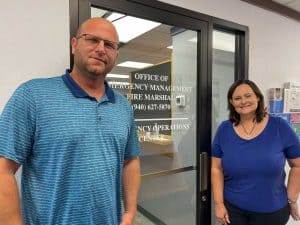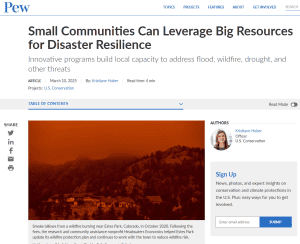Counties and cities in Texas abide by complex rules when it comes to managing disasters. Combine that complexity with the vast differences in population and you will quickly find that population size is often correlated with resources such as access to information and the data needed make community improvements. Counties with many people and a large tax base often have an entire office of emergency management staff where people specialize in activities like outreach and public education, conducting exercises to prepare for disasters, writing grants to upgrade failing infrastructure, and applying for funding to prepare, respond, and recover when disasters hit. Furthermore, larger counties and cities also have trained experts, including Certified Engineers and Certified Floodplain Administrators (CFA), who make informed decisions around how to build homes and businesses that take flood plains into account.
This isn’t the case with more rural counties and cities with few people and a smaller tax base. Thirty-eight of the 253 counties in Texas have fewer than 3,500 people. Many of them have no CFA or County Engineer, and their Emergency Management Coordinator and people who help apply for funding are only part time since they have many other job responsibilities. This is the case in two rural counties I’ve visited this year: Hudspeth County and Jeff Davis County, but that doesn’t stop them from joining together to try to address their growing flood concerns. Learn more about their efforts: https://idrt.tamug.edu/bridging-the-data-gaps-for-rural-texas/ .
Rural, but Growing
Wise County, a fairly rural county just north of the Dallas Fort Worth area, has 71,000 people, and is really growing. This county is in a unique position because a 10,000-home housing development is happening in their county. This is a county that often experiences flooding and wildfires, and they know that managing this growth is vitally important for all their community members.
 Wise County has recently invested in a full-time Emergency Management Coordinator position, Cody Powell, who is actively working to educate all the stakeholders in the county concerning how his office can help. Since this position is new, he and his team are engaged in outreach and community education. For example, Leadership Decatur, local business owners in the Decatur, Texas area, recently visited his office where he explained what an Emergency Operation Center is and the complexity of coordinating all the different stakeholders during emergencies. (Link to this https://www.co.wise.tx.us/418/Office-of-Emergency-Management)
Wise County has recently invested in a full-time Emergency Management Coordinator position, Cody Powell, who is actively working to educate all the stakeholders in the county concerning how his office can help. Since this position is new, he and his team are engaged in outreach and community education. For example, Leadership Decatur, local business owners in the Decatur, Texas area, recently visited his office where he explained what an Emergency Operation Center is and the complexity of coordinating all the different stakeholders during emergencies. (Link to this https://www.co.wise.tx.us/418/Office-of-Emergency-Management)
At the end of his presentation, his team handed out disaster preparedness kits and discussed the importance of planning for the most common disasters in their area: fires, floods, and tornados. These are the same disaster preparedness kits they have handed out at community events and schools because they want to help their entire county be prepared.
Wise County is fortunate in many ways. Despite being rural, they also have an experienced, Certified Floodplain Administrator, knowledgeable County Commissioners, a County Judge who prioritizes emergency management and public safety, a helpful Council of Governments (COG), and good relationships with many cities in their county. Their challenges center around the fact that they are growing rapidly, and as buildings and homes are built, that also changes how water will flow and be absorbed when they experience heavy rains or need to let water out from their reservoirs—something that happens several times a year.

Anticipating the impacts growth will have on how water flows and the potential for increased flooding in places that have never flooded before creates new challenges. The county officials need access to data, software, and adequate broadband to analyze data to better understand their changing county. They also need people trained to use these data products to help them be prepared for the future.
This is where our DRIP project enters the picture. This project works to enhance the capacity of rural counties in Texas by improving their digital infrastructure. Our project is in the pilot stage now, and every community we work with will get a customized solution. The solutions range from providing them access to data they need to possibly helping them with data tools that help them better plan and apply for funding as they manage their increasing flood concerns. We also provide these communities with access to the growing list of resources available for Texans, like the Texas Water Development Board’s Community Officials Flood Resource Guide (https://www.twdb.texas.gov/flood/resources/doc/Community-Officials-Flood-Resource-Guide-Volume-1.pdf) and a growing list of resources help small businesses prepare for disasters https://texastipi.org/project/smallbusinessresources/ Stay tuned as we continue making progress on our DRIP project.






